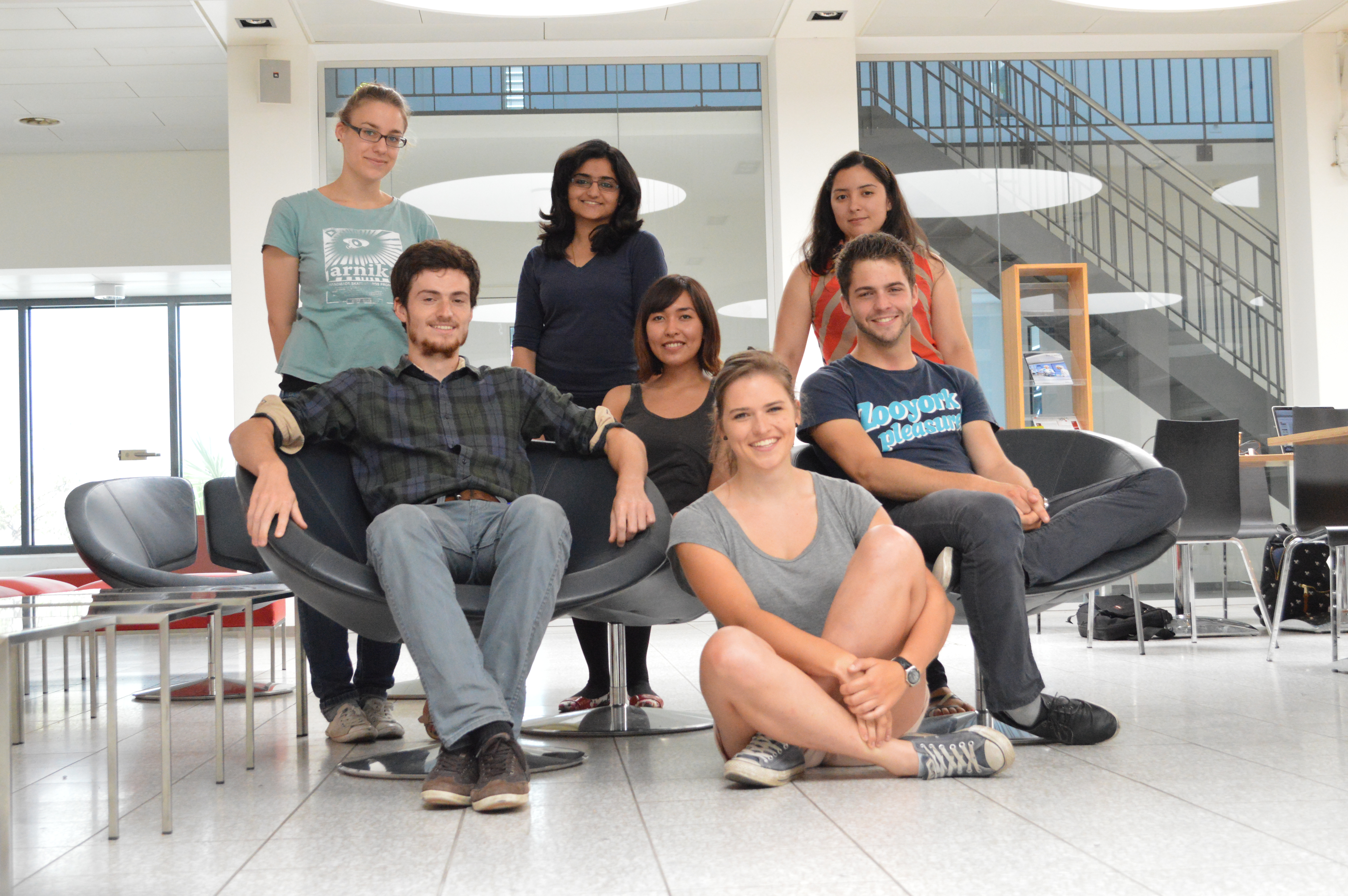|
|
| Line 22: |
Line 22: |
| | <li> | | <li> |
| | <a href="/Team:ETH_Zurich/Project"><img src="https://static.igem.org/mediawiki/2013/1/18/Circuit_Minesweeper.png"/></a> | | <a href="/Team:ETH_Zurich/Project"><img src="https://static.igem.org/mediawiki/2013/1/18/Circuit_Minesweeper.png"/></a> |
| - | <p style="font-size:14.5px" align="justify"><b>From Minesweeper to Colisweeper</b><br> Colisweeper is a biological version of the Minesweeper computer game. The minefield is replaced by mine and non-mine colonies on an agar plate. Quorum sensing molecule OHHL communicates between colonies that are designed to express different orthogonal hydrolases depending on the signal processed. By pipetting a colorless multi-substrate mix onto mine or non-mine colonies, color appears and indicates the next logical move for the player. In order to flag a mine, a second single substrate can be pipetted on the mine colony. | + | <p style="font-size:14.5px" align="justify"><b>From Minesweeper to Colisweeper</b><br> Mines secrete the signaling molecule N-(3-oxohexanoyl)-l-homoserine lactone (OHHL) whereas non-mines process the signal. High-pass filters were constructed to control the expression of different orthogonal hydrolases in non-mines, depending on the number of surrounding mines. Additionally, the mines express their own hydrolase. |
| | </p> | | </p> |
| | </li> | | </li> |

-

Colisweeper
Colisweeper is an interactive, biological version of the Minesweeper computer game, based on luxI/luxR quorum sensing and chromogenic enzymatic reactions. The goal is to clear an agar “minefield” without detonating mines. Genetically engineered Escherichia coli colonies are used as sender-cells (mines) and receiver-cells (non-mines). Mines secrete the signaling molecule N-(3-oxohexanoyl)-l-homoserine lactone (OHHL) whereas non-mines process the signal. To distinguish between OHHL-levels, a library of PLuxR promoters with various sensitivities was created through site-saturation mutagenesis. High-pass filters were constructed to control the expression of different orthogonal hydrolases in non-mines, depending on the number of surrounding mines. Additionally, the mines express their own hydrolase.
-

Gameplay
To play Colisweeper, a colorless substrate solution is pipetted onto a colony of choice. The result is a defined color change within minutes, allowing identification of the played colony and the number of mines surrounding it.
-

From Minesweeper to Colisweeper
Mines secrete the signaling molecule N-(3-oxohexanoyl)-l-homoserine lactone (OHHL) whereas non-mines process the signal. High-pass filters were constructed to control the expression of different orthogonal hydrolases in non-mines, depending on the number of surrounding mines. Additionally, the mines express their own hydrolase.
-

Information Processing
The non-mine colonies are designed to distinguish between different concentrations of OHHL and translate this information into expression of different sets of hydrolases. They are equipped with mutated LuxR promoters with different OHHL sensitivities which serve as highpass filters. The promoters were created using site-saturation mutagenesis. Through mutation of the LuxR binding sites we were able to tune the promoters to different OHHL affinities .
-

Hydrolase Reactions
We use a set of orthogonal hydrolases as our reporter system that react within minutes with the added multi-substrate to produce a visible color. The set of hydrolases such as alkaline phosphatase (phoA), β-galactosidase (lacZ), acetylesterase (aes), β-N-Acetylglucosaminidase (nagZ) and β-glucuronidase (gusA) and their respective substrates react to achieve fast and colorful outputs with each color indicative of the next logical move for the player.
-

The Model
As our system is based on quorum sensing of OHHL, the diffusion of OHHL in the mine field is a vital part of the system. We study the diffusion in our system in a hexagonal grid format with mine and non-mine colonies using a spatio-temporal model. The information from the model was used to validate and improve our system.
-

Experiments
Starting with characterization of the OHHL diffusion in agar plates we went on to test different sender- and receiver-cell pairs in the hexagonal grid. Initially we used Green fluorescent Protein (GFP) as a reporter to study the OHHL interaction between mine and non mine colonies. Together with promoter mutagenesis and screening, we also tested and characterized different hydrolase-substrate pairs which are crucial to get the game going!
-

Human practices
Inspired by our Colisweeper project, we analyzed the relationship between synthetic biology and games. For one thing synthetic biology can be used to play common games in a new way, possibly for educational purposes or as a basis for proof-of-principle experiments for new circuits. More recently synthetic biologists also started to use games as a research tool, an innovative approach to make use of crowd-sourcing and distributed computing. We want to find correlations and discuss possible consequences for Synthetic Biology.
-

Team
We are a team of seven highly motivated Bachelor- and Master Students at ETH Zürich pursuing various fields such as Biotechnology, Biomedical Engineering, Neurobiology and Bioinformatics. The iGEM project is carried out at one of the youngest departments of ETHZ located in Basel-Department of Biosystems Science and Engineering - flourishing in interdisciplinary biological research. If you're around Basel, make sure to visit our team's lab to play the bio-game Colisweeper!
Colisweeper is an interactive, biological version of the Minesweeper computer game, based on luxI/luxR quorum sensing and chromogenic enzymatic reactions. The goal is to clear an agar “minefield” without detonating mines.
Genetically engineered Escherichia coli colonies are used as sender-cells (mines) and receiver-cells (non-mines). Mines secrete the signaling molecule N-(3-oxohexanoyl)-l-homoserine lactone (OHHL) whereas non-mines process the signal. To distinguish between OHHL-levels, a library of PLuxR promoters with various sensitivities was created through site-saturation mutagenesis. High-pass filters were constructed to control the expression of different orthogonal hydrolases in non-mines, depending on the number of surrounding mines.
Additionally, the mines express their own hydrolase.A spatiotemporal reaction-diffusion model was established to evaluate and improve the system. To play Colisweeper, a colorless substrate solution is pipetted onto a colony of choice. The result is a defined color change within minutes, allowing identification of the played colony and the number of mines surrounding it.
 "
"















